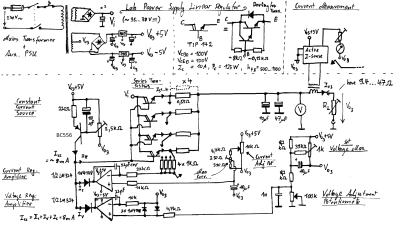The lab power supply is an essential part of any respectable electronics workbench. However, the cost of buying a unit that has all the features required can be eye-wateringly high for such a seemingly simple device. [The Post Apocalyptic Inventor] has showed us how to build a quality bench power supply from the guts of an old audio amplifier.
We’ve covered our fair share of DIY power supplies here at Hackaday, and despite this one being a year old, it goes the extra mile for a number of reasons. Firstly, many of the expensive and key components are salvaged from a faulty audio amp: the transformer, large heatsink and chassis, as well as miscellaneous capacitors, pots, power resistors and relays. Secondly, this power supply is a hybrid. As well as two outputs from off-the-shelf buck and boost converters, there is also a linear supply. The efficiency of the switching supplies is great for general purpose work, but having a low-ripple linear output on tap for testing RF and audio projects is really handy.

The addition of the linear regulator is covered in a second video, and it’s impressively technically comprehensive. [TPAI] does a great job of explaining the function of all the parts which comprise his linear supply, and builds it up manually from discrete components. To monitor the voltage and current on the front panel, two vintage dial voltmeters are used, after one is converted to an ammeter. It’s these small auxiliary hacks which make this project stand out – another example is the rewiring of the transformer secondary and bridge rectifier to obtain a 38V rail rated for twice the original current.
The Chinese DC-DC switching converters at the heart of this build are pretty popular these days, in fact we’re even seeing open source firmware being developed for them. If you want to find out more about how they operate on a basic level, here’s how a buck converter works, and also the science behind boost converters.















my variation of DIY powersupply (dual type linear and DC/DC convertion) https://imgur.com/a/el57T ;)
Just looking at that schematic I have some questions, for one is that only a single tap? Thats going to get hot
And two, what’s a transformer current sense doing on the DC side?
And not to say it’s not better to build your own psu for the learning experience but I got a good rebranded dual 5a 30v mastech linear supply from Amazon for $80 delivered, stuck some 10 turn pots on the thing and it’s been great for over a year (and mastech was even so kind as to send me the schematic)
Yep, single tap, needs lots of cooling to keep it cool.
The “transformer current sense” looks like a hall effect current sensor, which can sense both DC and AC current.
He said he covered that sensor in another video, which I haven’t seen yet.
From skipping around the Video I learned that they use switching regulators and a linear regulator for different outputs. Maybe I was missing something but now I wonder:
Could I use a switching regulator for create a voltage 1V above my desired output and then a linear regulator for fine tuning? I guess it could combine the efficency of switching and noise of linear regulator?
That is a well known technique. Google for “linear post regulator”.
Rather than position the DC/DC output 1V above the *desired* output, it’s common to put it 1V above the *actual* output. This way, the dissipation in the linear regulator will be controlled during shorts / constant current mode, etc.
And if that does not work, try: “switching pre regulator” :)
Thank you Allan and Paul!
That’s exactly what I was looking for!
” I guess it could combine the efficency of switching and noise of linear regulator?”
Maybe it will combine the noise of a switcher and the efficiency of a linear?
B^)
From the other comments it looks like there’s some debate about the internal arrangement, but I think we can probably all agree it’s a beautiful looking piece of kit from the outside.